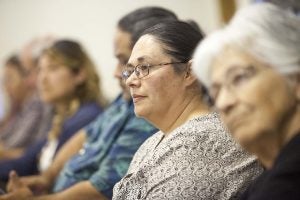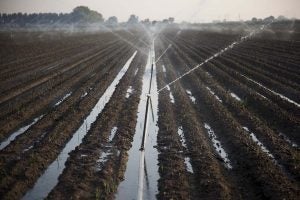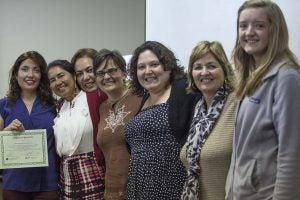
Water board leaders from 13 communities throughout California’s Central Valley attended the Leadership Academy to build engagement capacity and share lessons about small water system management. (Credit: Kike Arnal)
California’s Central Valley, which stretches 450 miles from Redding in the north to Bakersfield in the south, is the nation’s richest agricultural region, producing 40 percent of our fruit, vegetables and nuts on nearly 9 million acres of irrigated farmland. The Valley is also ground zero for California’s water problems.
As California endures its fifth year of drought, cities, farms, and communities across the state are experiencing severe water stress. Rivers, lakes and reservoirs are drying up, so residents are turning to groundwater pumping to quench their thirst. As a result, many of the state’s groundwater aquifers are being depleted, causing wells to run dry or become contaminated.
The most critically overdrawn aquifers are in and around small, rural communities in the Central Valley. Here, thousands of people—many of them low-income farm workers—live without safe drinking water.
I’ve seen this crisis unfold firsthand. As a groundwater project manager for Environmental Defense Fund, I’ve spent a lot of time in the Central Valley. I’ve seen what can happen when a well runs dry and I’ve experienced the helplessness of families affected most by the drought.
A new policy to the rescue

California’s Sustainable Groundwater Management Act (SGMA) requires local districts to maintain safe levels in their underground aquifers. (Credit: Kike Arnal)
Not surprisingly, water scarcity is not the only issue driving this imbalance in California’s water system. The state’s convoluted water policies, legacy infrastructure projects and burdensome water politics perpetuate the issue, making it exceedingly difficult to deal with water shortages.
To tackle the crisis and bring more balance to the way water is managed, the California Legislature passed the Sustainable Groundwater Management Act (SGMA) in 2014. The law requires local districts to maintain safe levels in their aquifers but offers little guidance on how to do so. Luckily, local residents have stepped up and volunteered to serve on local water boards to sketch out a plan for sustainable water management.
This will not be an easy task. Small community water boards have very little financial, political or institutional support. Historically these groups have been excluded from regional and state discussions about water management, which has made the crisis worse. Often larger agencies dominate the conversation and small community water managers are not allowed a seat at the table.
But I want to change that dynamic.
Introducing the Leadership Academy
Together with the Rural Community Assistance Corporation (RCAC) and Self Help Enterprises, my team at EDF convened a series of bilingual workshops (known as the Leadership Academy) in Visalia, California.
For six months, rural water board leaders from 13 communities met once a month to develop and practice skills that will help them become better advocates for their communities. The training included lessons about SGMA, its implications, and ways for small water system leaders to get involved. Importantly, the workshops aimed to build engagement capacity of rural community leaders and to bridge the communications gap with policy makers.
Many stories emerged over the course of the workshops. Stories of challenge, struggle and heartbreak. Stories that showed just how difficult life has been for communities in the Central Valley without water.

We will continue to support and work with local communities in future iterations of the Leadership Academy. (Credit: Kike Arnal)
But these stories also gave me reason to hope. I saw communities coming together. I saw leaders and water heroes emerging and on a mission. I heard innovative and inspiring ideas to not only address local water shortages, but to fix California’s water system as a whole. Most importantly, I met an amazing group of passionate and committed local water leaders – individuals who have voluntarily stepped out of their comfort zone to learn and better serve their communities.
In November, we graduated a cohort of 30 Leadership Academy participants. They now have the tools and skills they need to change the water conversation at the state-level. Their voice will be a vital component of California’s plan to overcome its water crisis and build resiliency to climate change.
Related:
These reforms can unclog California’s water market and help the environment >>
From Mexico City to San Francisco: A multi-national perspective on water management >>
3 investment ideas to sustain water in the American West >>
One Comment
Leadership & knowledgeable voices emerging out of the community is the best thing that can happen. Their voices should’ve been at the table to begin with! Their experiences are direct, pertinent & they are well able to contribute viable ideas best suited to the broadest scope.